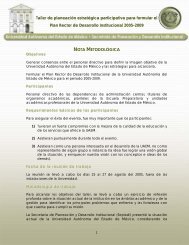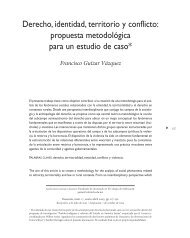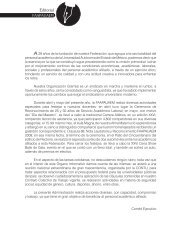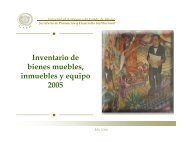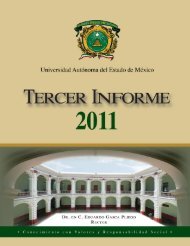Descargue el archivo - Universidad Autónoma del Estado de México
Descargue el archivo - Universidad Autónoma del Estado de México
Descargue el archivo - Universidad Autónoma del Estado de México
Create successful ePaper yourself
Turn your PDF publications into a flip-book with our unique Google optimized e-Paper software.
Las diferencias <strong>de</strong> género en la figura corporal idónea parecen vinculadas<br />
a los estándares <strong>de</strong> b<strong>el</strong>leza promovidos en los medios (revistas,<br />
juguetes, t<strong>el</strong>evisión, etcétera) y reforzados por <strong>el</strong> ambiente en<br />
<strong>el</strong> que se <strong>de</strong>senvu<strong>el</strong>ve <strong>el</strong> individuo (familia, pares y amigos).<br />
La figura corporal parece tener diferentes significados para los hombres<br />
y para las mujeres; generalmente, <strong>el</strong>las están motivadas para<br />
ser d<strong>el</strong>gadas mientras que <strong>el</strong>los muestran mayor ten<strong>de</strong>ncia a <strong>de</strong>sear<br />
aumentar la masa muscular.<br />
Las alteraciones graves en la imagen corporal se asocian con mayor<br />
probabilidad con trastornos d<strong>el</strong> comportamiento alimentario (anorexia<br />
y bulimia nerviosa) en las mujeres, y con trastorno dismórfico<br />
muscular en los varones.<br />
En la sociedad actual, la figura corporal se percibe como maleable<br />
(peso y figura), <strong>de</strong> tal forma que tanto mujeres como hombres hacen<br />
esfuerzos para alcanzar la figura corporal idónea, por lo cual realizan<br />
dietas, ejercicio y, en casos extremos, abusan <strong>de</strong> sustancias con<br />
<strong>el</strong> propósito <strong>de</strong> mol<strong>de</strong>ar <strong>el</strong> cuerpo (laxantes, diuréticos, esteroi<strong>de</strong>s<br />
anabolizantes). Es importante señalar que algunas investigaciones<br />
han sugerido que la conducta <strong>de</strong> dieta es un importante factor <strong>de</strong><br />
riesgo para <strong>el</strong> <strong>de</strong>sarrollo y mantenimiento <strong>de</strong> los TCA, sin embargo,<br />
hacen falta estudios sobre estas conductas y su vínculo con la etiología<br />
d<strong>el</strong> trastorno dismórfico corporal.<br />
Actualmente, en occi<strong>de</strong>nte se promueve la i<strong>de</strong>a <strong>de</strong> que <strong>el</strong> cuerpo<br />
<strong>de</strong>fine a las personas y se presentan anuncios que capitalizan la inseguridad<br />
<strong>de</strong> las personas. Estos anuncios incluyen dietas, suplementos<br />
alimenticios, programas para ad<strong>el</strong>gazar, remedios para <strong>el</strong> crecimiento<br />
d<strong>el</strong> p<strong>el</strong>o y productos para aumentar <strong>el</strong> <strong>de</strong>sempeño sexual. Una<br />
rápida revisión a las revistas evi<strong>de</strong>ncia este aspecto. A<strong>de</strong>más, en los<br />
anuncios se disemina <strong>el</strong> mensaje <strong>de</strong> que las personas necesitan <strong>de</strong><br />
estos productos para ser mejores personas.<br />
Cash, Thomas. 2002. “Body image: Cognitive behavioral<br />
perspectives on body image”, en Thomas Cash y Thomas<br />
Pruzinsky (Eds.) Body Images: A Handbook of Theory, Research,<br />
and Clinical Practice (pp. 38-46). Guilford Press, Nueva York.<br />
__________ y Pruzinsky, Thomas. 2002. “Future challenges<br />
for body image theory, research, and clinical, practice”, en<br />
Thomas Cash y Thomas Pruzinsky (Eds.), Body Images: A<br />
Handbook of Theory, Research, and Clinical Practice (pp. 509-<br />
516). Guilford Press, New York.<br />
Grieve, Fre<strong>de</strong>rick. 2007. A conceptual mod<strong>el</strong> of factors contributing<br />
to the <strong>de</strong>v<strong>el</strong>opment of muscle dysmorphia. Eating<br />
Disor<strong>de</strong>rs, 15, 63-80.<br />
Keeton, Presley; Thomas Cash y Timothy Brown. 1990. “Body<br />
image or body images? Comparative, multidimensional assessment<br />
among college stu<strong>de</strong>nts”, en Journal of Personal<br />
Assessment, 54, 213-230.<br />
Leone, James; Edward Sedory y Kimberly Gray. 2005. “Recognition<br />
and treatment of muscle dysmorphia and r<strong>el</strong>ated<br />
body image disor<strong>de</strong>rs”, en Journal of Athletic Training, 40, 352-<br />
359.<br />
Markula, Pirkko. 1995. “Firm but shap<strong>el</strong>y, fit but sexy, strong<br />
but thin: the postmo<strong>de</strong>rn aerobicizing female bodies”, en<br />
Sociology of Sport Journal, 12, 424-453.<br />
McCreary, Donald y Doris Sasse. 2000. “An exploration of<br />
the drive for muscularity in adolescent boys and girls”, en<br />
Journal of American College Health, 48, 297-304.<br />
McDonald, Karen y Kevin Thompson. 1992. “Eating disturbance,<br />
body image dissatisfaction and reasons for exercising:<br />
Gen<strong>de</strong>r differences and corr<strong>el</strong>ational findings”, en International<br />
Journal of Eating Disor<strong>de</strong>rs, 11, 289-292.<br />
Mishkind, Marc y otros. 1896. “The embodiment of masculinity:<br />
Cultural, psychological, and behavioral dimensions”, en<br />
American Behavioral Scientist, 29, 545-562.<br />
Referencias<br />
Neumark-Sztainer, Dianne y otros. 1999. “Socio<strong>de</strong>mographic<br />
and personal characteristics of adolescents engaged in<br />
weight loss and weight/muscle gain behaviors: who is doing<br />
what?”, en Preventive Medicine, 28, 40-50.<br />
Paxton, Susan, y otros. 2006. “Body dissatisfaction prospectiv<strong>el</strong>y<br />
predicts <strong>de</strong>pressive symptoms and low s<strong>el</strong>f-esteem<br />
in adolescent girls and boys”, en Journal of Clinical Child and<br />
Adolescent Psychology, 35, 539-549.<br />
Pope, Harrison; Debra Katz y James Hudson. 1993. “Anorexia<br />
nervosa and reverse anorexia among 108 male bodybuil<strong>de</strong>rs”,<br />
en Comprehensive Psychiatry, 34, 548-557.<br />
Pope Harrison y otros. 1999. “Evolving i<strong>de</strong>als of male image<br />
as seen through action toys”, en International Journal of Eating<br />
Disor<strong>de</strong>rs, 26, 65-72.<br />
Ricciard<strong>el</strong>li, Lina; Marita McCabe y Damien Ridge. 2006.<br />
“The construction of the adolescent male body through<br />
sport”, en Journal of Health Psychology, 11, 577-587.<br />
Rodin, Judith; Lisa Silberstein y Ruth Strieg<strong>el</strong>-Moore. 1985.<br />
“Women and weight: A normative discontent”, en Son<strong>de</strong>regger<br />
(Ed.), Psychology and gen<strong>de</strong>r: Nebraska Symposium<br />
on Motivation 1984 (pp. 267-307).: University of Nebraska<br />
Press, Lincoln, NE.<br />
Thompson, Kevin y otros. 1999. Exacting beauty: Theory, assessment,<br />
and treatment of body image disturbance. American<br />
Psychological Association, Washington DC.<br />
Toro, Josep. 1996. El cuerpo como d<strong>el</strong>ito, anorexia bulimia y<br />
sociedad. Ari<strong>el</strong>, Barc<strong>el</strong>ona.<br />
Podríamos concluir que las personas tienen razones positivas y negativas<br />
para ejercitarse. Las negativas están asociadas con la insatisfacción<br />
corporal (dieta restrictiva o hipercalórica) y las positivas se<br />
enfocan a la salud.<br />
120 121



